Hawks are a type of bird of prey, and they are known for their powerful talons and sharp vision. While hawks are capable of flying and soaring through the air with ease, many people wonder if these birds can also swim.
The answer is no. Hawks lack webbed feet, which means they cannot paddle through the water. In short, they don’t have the tools for swimming.
However, young hawks sometimes catch their prey by scooping down from the sky and plunging into bodies of water. Even though their lightweight bodies allow them to float, they have little control over where they go in the water.
Can an Adult Bird Such as a Hawk Fly When Wet?
Hawks are one of the most impressive groups of birds when it comes to flight. Their wings are specially adapted to help them soar through the air with ease, and they are able to reach high speeds and perform complicated maneuvers.
However, there is one thing that can ground this bird- water. Even if hawks have a preen gland to keep their plumage waterproof, the outermost part can still get soaked.
When these get drenched, red-shouldered hawks and most other hawks are unable to fly. The water weighs down and makes it difficult to get airborne.
In addition, drenched plumage loses its insulating properties, making it harder for hawks to keep warm. As a result, these birds will go to great lengths to avoid getting wet. They will perch in protected areas during storms and groom themselves meticulously after taking a bath.
So, if you’re lucky to see a red-tailed hawk taking a rest and sitting out in the rain in the wild, don’t worry – it’s just waiting for its body to dry off before it can take to the skies again.
Are Red-Tailed Hawks Waterproof?
Like other birds, falcons and hawks have tools to waterproof their plumage by using their beaks to coat the intricate weave plumage with oil from the preen gland. This is sometimes called “preening.” Even a bald eagle can preen.
The preen gland is located at the base of the tail of a red-shouldered hawk and produces an oil that is rich in fatty acids. This oil helps to keep feathers from absorbing water and becoming heavy, which can make it difficult for birds to fly.
In addition, the oil helps to keep their plumage from matting down, which can reduce insulation and provide a way for bacteria and parasites to enter the body.
They use their beaks to transfer the oil from the preen gland to their feathers, ensuring that their plumage remains healthy and waterproof.
Can a Hawk Dive Underwater?
Unlike other raptors, the osprey has access to excellent sight and is the only raptor known to dive into the water with its legs and feet positioned on either side of its head to catch its food.
Ospreys do their hunting near bodies of water as such you can find the nest in nature a few miles from an ocean or sea.
Should You Rescue a Hawk if You Notice One in Your Swimming Pool?
Hawks are naturally curious animals, and it’s not uncommon for them to investigate strange objects in their environment.
If you find a hawk in your swimming pool, it’s important to approach the situation with caution. The bird may be injured or dehydrated, and it could become aggressive if it feels threatened.
The best way to rescue the bird is to secure it with a large towel or blanket. Once the bird is covered and on a dry surface and out of the pool, call your local wildlife rescue services and wait for a trained professional to arrive.
In the meantime, make sure no children and pets have access to the animal or the pool.
The Takeaway on Can a Hawk Swim and Dive
Hawks cannot swim. They simply don’t have the tools to swim. In fact, they are quite terrible at it! This little bit of trivia may not seem important, but it actually has some interesting implications for how these birds live and hunt.
Next time you see a hawk perched high in a tree, remember that even though it looks like it would be graceful gliding through the water below, in reality, it would be more likely to sink like a rock. While they may not know how to swim, they have other ways to survive in the wild.
FAQs Do Hawks Swim
What Predatory Birds Have the Ability to Swim?
While most birds are able to fly, there are a few species that have adapted to life in the water. Perhaps the most well-known swimming birds are the ducks, but there are raptor species that have the ability to swim. This includes the Bald Eagle and the Great Horned Owl.
When necessary, owls will enter the water in order to bathe their plumage and remove any dirt or parasites. While swimming, owls use have access to their wings to paddle through the water and their feet to steer.
They are generally not graceful swimmers, but you can see their head and neck and they can stay afloat for long periods of time if necessary. In fact, owls have even been known to drown if they become caught in a storm or are unable to find a safe place to perch.
Do Hawks Eat Fish?
Hawks are birds of prey. They have the tools to be efficient and fierce hunters. They are constantly on the lookout for their next meal. A young bird hawk typically eats small animals like chickens and mammals, such as rodents, frogs, and rabbits. While a larger hawk can take down animals as large as deer.
In addition to their usual diet prey, hawks will also eat birds, reptiles, and amphibians. They have even been known to kill and eat other hawks. And while they typically stick to hunting on land, some species of the hawk are known to eat fish.
Generally, these types of hawks live near water sources, such as a river or a lake where they can easily snatch fish out of the water. So, while it is not their usual fare, these birds will occasionally eat fish.
Do Hawks Eat Snakes?
Hawks are predators that hunt a variety of prey, including snakes. While some hawks will avoid eating them due to the risk of being bitten, others have no problem preying on these reptiles. In fact, the Harris’ hawk is a specialized snake hunter. Additionally, red-tails are particularly fond of rattlesnakes.
Is an Osprey a Hawk?
The osprey is also known as the sea hawk, river hawk, and fish hawk. It is a diurnal bird of prey reaching more than 60 cm in length and 180 cm across the wings. It is brown on the upper parts and predominantly greyish on the head and underparts.
Do Hawks Eat Gulls?
A gull is instinctively afraid of birds of prey, particularly eagles, falcons, and hawks. A hawk will occasionally hunt a gull.
Are Red-Tailed Hawks Endangered?
For many years, hawks were persecuted by humans and their numbers declined sharply. However, thanks to federal protection and conservation efforts, the population has rebounded and the hawks are no longer considered endangered.
Do Hawks Nest in Trees?
Yes, these birds nest in trees using sticks, branches, and twigs. After searching and choosing a nesting site, they make sure that their nest is ready for the breeding season so that the female has a safe site to lay her eggs.

Jim Addison is an avid bird watcher and has been obsessed with the activity since he was a young boy.
He has traveled all over North America in search of new and interesting species to observe, and his detailed knowledge of the subject makes him a sought-after expert on the topic.


